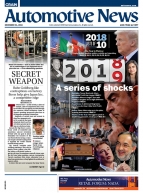As interest rates rise and margins continue to tighten, the F&I department bears the last-stop burden, the dealership's last chance at profit.
Because retailers have enjoyed historically low interest rates the past several years, dealerships — and especially their F&I departments — must readjust.
The National Automobile Dealers Association forecasts that new-vehicle sales will fall to 16.8 million in 2019, down from the 17 million it projects for 2018. If NADA's forecast is accurate, 2019 would mark the first time U.S. new-vehicle sales dip below the 17-million mark since 2014.
For F&I managers who have never worked in a down market, the challenge could be illuminating.
Pressure on the F&I office is heightening because of the squeeze happening on the front end of the transaction, Jim DeTrude, vice president for sales and marketing at Nissan Motor Acceptance Corp., said this year.
As new-vehicle sales margins continue to tighten, dealers will pull every lever to earn a profit. The pressure on F&I will continue to increase, added Marc Womack, COO of TD Auto Finance, especially if captives and automakers trim incentive offers. "The F&I department will have to hold the day in terms of profit," he said.
Many F&I departments in recent years have innovated on the operations side using advanced technology and product menus, adjustments in finance reserve standards and even hybrid sales-F&I roles.
As F&I earnings become even more critical in the years ahead, dealerships should continue to experiment to make their F&I departments as efficient as possible.

